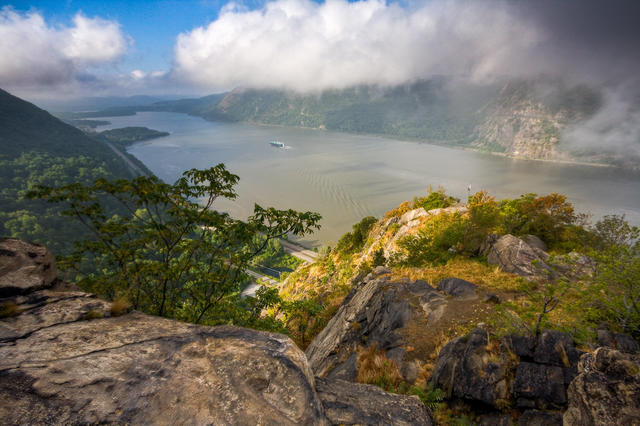Home » Regions » North America » Northern Forests » Atlantic Highlands » Northeastern Highlands » Glaciated Reading Prong/Hudson Highlands
Glaciated Reading Prong/Hudson Highlands
Last updated: March 30th, 2022
Page contents
↑About the Glaciated Reading Prong/Hudson Highlands
The Glaciated Reading Prong / Hudson Highlands is the more northeasterly, glaciated counterpart to the Reading Prong. Underlain by the same metamorphic rock and essentially part of the same geological formation, this region was glaciated during the most recent (Wisconsin) glacial period, and has a set of unique features as a result. The region stretches through northern New Jersey into the area of New York state just north of New York City. The Hudson river cuts through this region, and there are steep hills along both banks where it does.The terrain consists of tall hills made of metamorphic rock, but with the addition of glacial deposits. The location of rock outcroppings and distribution of glacial drift is irregular, leading to patches of different soil types and variable topography. There are numerous glacial lakes, absent from the more southerly portion of the Reading prong formation, and more wetlands overall. Upland areas consist mostly of erosion-resistant gneiss, whereas valleys are underlain by limestone and shale.
This area was originally covered forests transitional between mixed oak forest to some northern hardwood forests in the north. Dominant tree species include sugar maple (Acer saccharum), American beech (Fagus grandifolia), sweet birch (Betula lenta), tuliptree (Liriodendron tulipifera), northern red oak (Quercus rubra), white oak (Quercus alba), and chestnut oak (Quercus montana), shagbark hickory (Carya ovata), and pignut hickory (Carya glabra), with beech and sugar maple more common in the north and oaks and hickory more common in the south. Cool, moist north-facing slopes, especially in the north, supported beech, sugar maple, and eastern hemlock (Tsuga canadensis). Poorly-drained sites supported wooded swamps of red maple (Acer rubrum), green ash (Fraxinus pennsylvanica), and swamp white oak (Quercus bicolor), and tupelo (Nyssa sylvatica). Throughout the region, key understory plants include mountain laurel (Kalmia latifolia), flowering dogwood (Cornus florida), black huckleberry (Gaylussacia baccata), and blueberries. Exposed areas around bedrock outcroppings supported serviceberry (Amelanchier sp.), chokecherry (Prunus virginiana), black cherry (Prunus serotina), and bear oak (Quercus ilicifolia).
Much of the forest cover remains on rugged upland sites. There are numerous state forests and parks, both in New Jersey and New York state. Lower, flatter sites have some agriculture and some residential development, but for the most part this region represents the first region moving north from New York City that has been spared suburban and industrial development, and instead has large swaths of intact forest.
This region is bordered to the southwest by the unglaciated portion of the Reading Prong, to the southeast by the lower-altitude and more heavily developed Glaciated Triassic Lowlands, and slightly farther east, by the Southern New England Coastal Plain and Hills. At the northeast it borders the Western New England Marble Valleys. North, along the Hudson river, it borders the Hudson Valley, and west of that, the Northern Glaciated Shale and Slate Valleys, and then the Northern Glaciated Limestone Valleys.
 This photo is taken from Breakneck Ridge, and shows where the Hudson River cuts through the Reading Prong formation. The rugged topography and forested landscape is typical of the region, although the steep slopes along the river are particularly dramatic. Photo © Jeff Pang, CC BY 2.0.
This photo is taken from Breakneck Ridge, and shows where the Hudson River cuts through the Reading Prong formation. The rugged topography and forested landscape is typical of the region, although the steep slopes along the river are particularly dramatic. Photo © Jeff Pang, CC BY 2.0.Plant Lists & In-Region Search
We do not yet have data to generate plant lists for a region as fine-tuned as this one. However you can move up to the broader Northeastern Highlands and generate lists for that region: native plants or all plants. Or search that region's plants here:
↑References
1. Woods, A.J., Omernik, J.M., Moran, B.C. "Level III and IV Ecoregions of New Jersey", (2007) Web.
2. Bryce, S.A., Griffith, G.E., Omernik, J.M., Edinger, G., Indrick, S., Vargas, O., and Carlson, D. "Ecoregions of New York (Poster)", U.S. Geological Survey (2010) Web.


